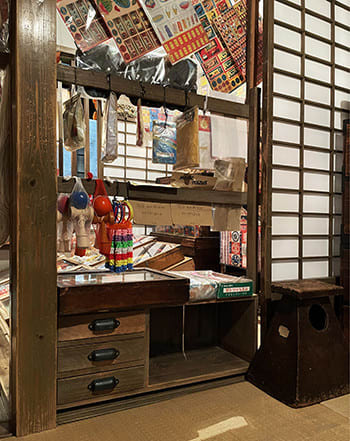



人間空間の広さを表す概念として日本人は非常に優れた「畳」という寸法感覚を持っている。立って半畳寝て1畳、という表現をよくしている。徳川家康のように天下を統一しても、個人としての人間に必要な空間面積はその程度だよ、という平等、民主主義的な思考法が根付いているのでしょう。
そういう空間認識はあらゆる場所で体験学習してきていると言えるけれど、今回テーマとしている駄菓子屋さんの子どもたちへの教育体験の刷り込みは、こういう常識を涵養するのに非常に役立っていたのではと思っている。いちばん上の写真は、玄関土間を中心にしたこの駄菓子屋さんの足下見下ろし。左手には座り作業での「台所・水回り」空間も同居している。全体としてはおおむね4.5畳の空間で右手側が店舗部分。土間には大人の靴が置かれているけれど、子どもたちの靴だとしても3−4人分であふれかえっていただろう。
2枚目と3枚目の写真は店舗部分。正面写真はカラフルできらびやかな駄菓子と玩具類のアイキャッチが子どもたちの印象の大海すべてを独占するように直撃してくる。店舗側の徹底攻撃はすばらしくアイコンのそれぞれの寸法は子どもに合わせてごく小さいけれどそれらの大量一気陳列で、こども心を一気に全面開放し、自由な時間が展開するように仕掛けられている。やや丹念に注意を向けていくと、やがて右手に幅30cm程度の通路があってひとあし一足確認しながら行けば、奥にも行けるように誘導している。手前側にはメインの菓子類が置かれ、奥の壁面には棚などが立体的に積み上げられている。商品とPOP類が渾然一体の空間。


こちらの写真は店舗側からみた購入窓口面。デコレーションの真ん中くらいに窓が開いていて、店主の母娘がやさしい笑顔で接客してくれた。下の写真は「番台」のような売り手側の対応窓口内部。この駄菓子屋は大正年代の様子を再現したものだという。キャラメル1箱が10銭ほどの値段で「最高級金額商品」で、ほとんどの子どもたちは1銭2銭の小遣いを握りしめて、個別品を購入していた。
「おばさん、これください」「いつもありがとうね」
やさしい商取引の会話が残照してくるような気がする。
ほんの少額の取引とはいえ、子どもたちにとっては子ども心の開放空間なので、それこそ放課後の貴重な社会交流の場でもあっただろう。狭い空間だけれど、だからこそむしろ子どもたちの「専有性」は高い空間だったことだろう。なんといっても大人には、それこそ足の踏み場もないし、まっすぐに立っていることも難しい空間。この駄菓子屋が集合場所でここを起点にして自由な遊びの時間が共有されていたことだろう。子どもたちの秘密基地にしてベースキャンプ。残しておきたい懐かしい時代を映す鏡でしょう。
PS:この冬一番の今朝の大雪、体感積雪50cmの除雪あらかた完了。ふ〜〜〜。
English version⬇
[A dream space of 3 tatami mats to find a place to step into: "Space Density" in a downtown row house - 2
Because it is a small space, adults cannot move freely, so it fits the children's space dimensions. Children's free heaven space. ・・・・・.
The Japanese have a very good sense of "tatami" dimensions as a concept for expressing the size of human space. It is often expressed as "half a tatami for standing and one tatami for sleeping. It is probably rooted in an egalitarian and democratic way of thinking that even if one unifies the country like Tokugawa Ieyasu, the space area required for an individual human being is just that much.
Such spatial awareness can be said to have been learned through experience in all kinds of places, but I believe that the imprinting of educational experiences on the children of the candy store, which is the theme of this project, was very useful in cultivating this kind of common sense. The photo at the top is a view of the entrance to the candy store, centered on the earthen floor. On the left, the "kitchen and water area" for sitting and working is also co-located. The overall space is roughly 4.5 tatami mats in size, with the store portion on the right hand side. The earthen floor is filled with adult shoes, but even if it were children's shoes, it would have been overflowing with 3-4 people's shoes.
The second and third photos show the storefront. The front photo is a colorful and glittering eye-catcher of candy and toys, which seems to dominate the entire sea of children's impressions. The store's thorough attack is amazing, and although the dimensions of each icon are very small for children, the massive display of these items is designed to open up children's minds to the full extent and allow them to have free time. If you pay close attention, you will eventually come to an aisle about 30 cm wide on the right side, which leads you to the back of the store, one step at a time. The main confectionery is placed at the front, and shelves and other items are stacked three-dimensionally on the back wall. The products and POPs are all in one space.
This photo shows the purchase window side from the store side. There is a window in the middle of the decoration, and the owner's mother and daughter served us with friendly smiles. The photo below shows the inside of the "watch stand"-like window of the seller's counter. This candy shop is said to be a reproduction of the Taisho era (1912-1926). A box of caramels was priced at about 10 sen, which was the "top-end price product," and most of the children were buying individual items with their pocket money of 1 sen or 2 sen.
Auntie, please give me this," "Thank you for all your help.
I feel as if I can see the afterglow of gentle business conversation.
Even though it was only a small transaction, it was an open space for the children's hearts and minds, and it must have been a valuable after-school social exchange opportunity for them. Although it was a small space, it must have been a highly exclusive space for the children. For adults, it was a space where it was difficult to stand upright. This candy shop must have been a meeting place where they shared their free play time. It was a secret base and base camp for children. It is a mirror of a nostalgic era that we would like to preserve.
PS: This morning's snowfall was the heaviest this winter, and the removal of the 50 cm of snow was almost complete. Whew....



















